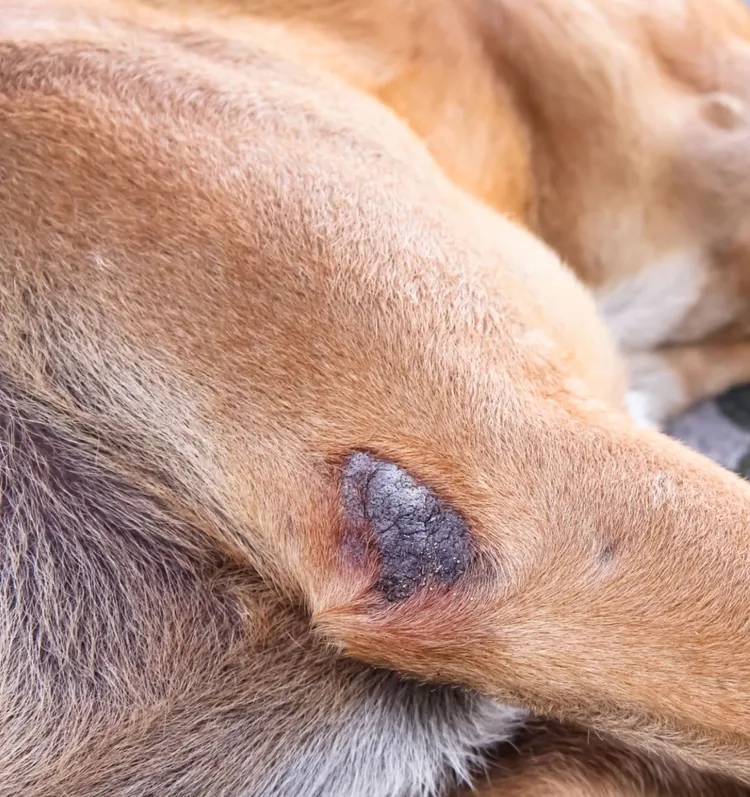Ever noticed unusual black patches on your dog’s skin and wondered what they might mean? While some darkening can be harmless, it can also signal underlying health concerns that need your attention. Early detection is key to keeping your dog healthy and comfortable, especially when the condition can progress if left untreated. As an eco-conscious dog owner, using sustainable, natural remedies and treatments is equally important. Let’s dive into the potential causes, symptoms, and treatments for black skin conditions in dogs, as well as how to manage them with eco-friendly solutions.
What Causes Black Skin in Dogs?
There are several possible reasons for black patches or discoloration on a dog’s skin, ranging from benign causes to more serious health issues. Understanding the underlying cause can help you determine the best course of action.
1. Hyperpigmentation
Hyperpigmentation refers to an excess of melanin in the skin, leading to darkened areas. It often occurs as a response to chronic irritation or inflammation. In many cases, hyperpigmentation is benign and doesn’t harm your dog, but it may be a sign that the skin is being repeatedly stressed or irritated by another factor such as allergies, infections, or friction.
- Symptoms: Dark patches on the skin, often in areas where there is rubbing or irritation.
- Common Areas: Groin, armpits, and belly.
- Treatment: Addressing the root cause of irritation can help prevent hyperpigmentation from worsening.
2. Allergies
Both environmental and food allergies can cause itching, which leads to scratching, licking, and chewing. Over time, this repeated trauma to the skin can result in darkened patches. These allergies might include reactions to pollen, dust mites, certain foods, or contact with irritants like chemicals or certain fabrics.
- Symptoms: Itching, redness, hair loss, and dark patches that develop in areas of constant licking or scratching.
- Treatment: Identifying and eliminating the allergen is crucial. You may need to experiment with your dog’s diet or switch to hypoallergenic products.
3. Hormonal Imbalances
Certain hormonal disorders like Cushing’s disease or hypothyroidism can cause a range of skin issues, including hyperpigmentation. In these cases, the dog’s body produces abnormal levels of hormones that affect the skin’s appearance, leading to black patches, thinning fur, or a dull coat.
- Symptoms: Hair loss, lethargy, weight gain, darkened skin, and thinning coat.
- Treatment: A vet will need to conduct blood tests to diagnose hormonal imbalances, and treatment usually involves medication to regulate hormone levels.
4. Infections
Yeast infections and bacterial infections are common culprits behind blackened or thickened patches of skin. Yeast infections, in particular, often occur in moist areas like skin folds, between the toes, or around the ears. If left untreated, these infections can worsen and spread.
- Symptoms: Foul odor, greasy skin, redness, itching, and darkened or thickened patches of skin.
- Treatment: Anti-fungal or antibiotic treatments prescribed by a vet. Maintaining cleanliness in skin folds can help prevent future infections.
5. Mange or Parasites
Mange is caused by microscopic mites that burrow into the skin, causing extreme irritation and hair loss. Over time, the affected areas may become darkened due to the chronic irritation and inflammation. Other parasites, such as fleas, can also lead to skin discoloration if the dog is scratching and biting themselves frequently.
- Symptoms: Severe itching, hair loss, sores, redness, and eventually black patches.
- Treatment: Prescription medications to eliminate mites or parasites. Natural flea repellents can help prevent future infestations.

How to Identify Black Skin Conditions in Dogs
Early identification of black skin conditions can help prevent complications. If you notice changes in your dog’s skin, it’s important to monitor their behavior and symptoms.
Signs to Watch For
- Itching: If your dog is scratching or licking excessively, it may lead to black patches from constant irritation.
- Redness or Flaky Skin: Dark patches often begin as red, irritated areas and may become flaky or crusty.
- Foul Odors: Infections often produce a noticeable odor, which is a sign of bacterial or yeast overgrowth.
- Hair Loss: In many cases, areas affected by black patches will also experience thinning fur or bald spots.
Areas Commonly Affected
Black skin patches are often found in areas where there is friction or moisture, such as the belly, armpits, groin, around the ears, and between the toes.
Progression of the Condition
If the underlying cause is left untreated, the skin can progress from red and irritated to thickened and blackened. Chronic conditions, like allergies or infections, often cause the skin to become darker over time.
Eco-Friendly Treatment and Prevention Tips
For eco-conscious pet owners, there are several natural and sustainable methods to treat and prevent black skin conditions in dogs.
1. Natural Shampoos
Opt for organic, chemical-free shampoos that contain soothing ingredients like oatmeal, aloe vera, or coconut oil. These ingredients help reduce inflammation and itching while being gentle on your dog’s skin. Look for shampoos with biodegradable packaging to minimize your environmental impact.
2. Dietary Adjustments
Incorporating omega-3 fatty acids into your dog’s diet can help reduce inflammation and support healthy skin. You can add natural foods like fish, flaxseeds, or chia seeds to your dog’s meals, or use omega-3 supplements that are sustainably sourced.
3. Eco-Friendly Parasite Control
Instead of harsh chemical treatments, consider using natural flea repellents made with essential oils like lavender, eucalyptus, or neem oil. Ensure these oils are diluted properly, as some essential oils can be harmful to dogs in high concentrations. There are also eco-friendly flea collars made from sustainable materials.
4. Home Remedies for Minor Cases
For minor skin irritations, aloe vera and coconut oil are effective natural remedies. Aloe vera has anti-inflammatory properties that can soothe irritated skin, while coconut oil has antibacterial properties to prevent infections. Apply these remedies directly to the affected areas in small amounts.
5. Regular Grooming
Grooming your dog regularly can prevent skin issues. For dogs with skin folds, clean these areas using natural pet wipes made from biodegradable materials. Keeping the skin dry and clean helps prevent yeast infections and other irritations.

When to See a Vet
While eco-friendly treatments can help manage mild skin conditions, some cases require veterinary attention. It’s important to consult a vet when:
- Persistent or Spreading Black Patches: If the black patches continue to spread or don’t improve with treatment, it may indicate a more serious condition like Cushing’s disease.
- Accompanying Symptoms: If your dog is showing additional symptoms like lethargy, rapid weight changes, vomiting, or diarrhea, they may need immediate medical attention.
Your vet can perform tests to diagnose the condition accurately and recommend appropriate treatments.
Conclusion
Black patches on a dog’s skin can be caused by a variety of factors, from benign hyperpigmentation to more serious health issues. Early detection and treatment are key to preventing complications, and eco-friendly solutions can be part of a natural and sustainable approach to pet care. Use organic shampoos, improve your dog’s diet with omega-3s, and choose natural remedies to manage minor skin issues. However, don’t hesitate to consult your vet if the condition worsens or is accompanied by other symptoms.
By staying mindful of your dog’s skin health and using eco-conscious methods, you can help your pet live a comfortable and healthy life.



